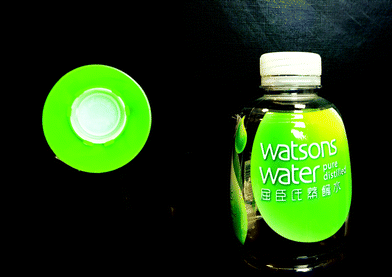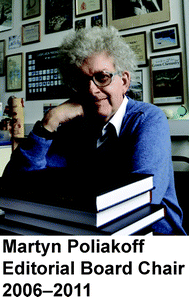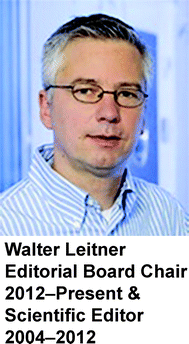15 years of Green Chemistry
James
Clark
a,
Roger
Sheldon
b,
Colin
Raston
c,
Martyn
Poliakoff
d and
Walter
Leitner
e
aDepartment of Chemistry, University of York, Heslington, York, YO10 5DD, UK
bDelft University of Technology, Julianalaan 136, 2628 BL Delft, The Netherlands
cSchool of Chemical and Physical Sciences, Flinders University, GPO Box 2100, Adelaide 5001, South Australia
dSchool of Chemistry, University of Nottingham, University Park, Nottingham, NG7 2RD, UK. E-mail: Martyn.Poliakoff@nottingham.ac.uk
eInstitut für Technische Chemie und Makromolekulare Chemie (ITMC), RWTH Aachen, Worringerweg 1, 52056 Aachen, Germany
Introduction
At the end of 2013 Green Chemistry completed 15 years of publication. To mark this significant milestone Chairs of the Editorial Board and Scientific Editors were asked for their views on the area of green chemistry, and the changes they have seen since the Journal was launched in 1999. The result is this Editorial with contributions from James Clark (Scientific Editor, 1999–2003), Roger Sheldon (Editorial Board Chair 1999–2001), Colin Raston (Editorial Board Chair 2002–2005), Martyn Poliakoff (Editorial Board Chair 2006–2011) and Walter Leitner (Scientific Editor 2004–2012 and Editorial Board Chair 2012–Present).15 years of Green Chemistry is being celebrated further by publishing a web collection covering topics of current importance in green chemistry, from those authors who have had the most highly cited articles from each of the past 15 years. The collection can be accessed online at http://rsc.li/gc-15-years.
The 15 year history of the journal parallels the development of green chemistry as a research area. I remember the great difficulties we had in persuading leading researchers that this new journal was the place to publish their best work. In many cases they simply did not see their work as relevant to green chemistry. Of course many were doing what we now recognize as good green chemistry and had indeed been doing relevant research for many years. Sister journals, such as Chemical Communications, published many articles in the 1980s on environmentally friendly catalysis and on cleaner methods of carrying out important organic transformations, such as oxidations and Friedel Crafts reactions. The situation today is very different – with multiple drivers including targeted funding, the amount of research claimed to be green chemistry has greatly increased as has the number of associated publications. The challenge today is the opposite of what we faced in the 90s – now we need to be more clear on what deserves to be classified as green chemistry. We cannot regulate research or standardize its outputs but we can strive to ensure that what we accept as the best green chemistry research continues to be cutting edge and continues to challenge the status quo. Green Chemistry reflects the need for the area to continuously develop: for example in recent years we have seen a dramatic growth in the number of articles on chemicals from renewable resources reflecting the increased importance of a life-cycle wide appreciation of chemicals. Articles today on solvents and catalysts are often much more considered than previously, when simply labeling your work as “catalytic” or using a non-VOC solvent was considered sufficient. I remember in the first board meeting the suggestion being made that if we do our job well we will no longer need a journal called Green Chemistry since all papers will reflect the principles of green chemistry. We are a long way from that and perhaps we should accept that there will always be the need for Green Chemistry as the flagship journal that always wants to be greener.
Green chemistry: a sustainable concept
The early 1990s saw the advent of a paradigm shift in our understanding of the implications of waste in the chemical industry and the meaning of efficiency in organic synthesis. This eventually led to the introduction of the term green chemistry. The first issue of the journal Green Chemistry saw the light of day in February 1999 following 18 months of market research, discussion and consultation. The choice of title was itself a subject of considerable deliberation. Many alternatives were considered but Green Chemistry was chosen for its simplicity, impact and widespread appreciation. In hindsight it couldn't have been a better choice. The main objectives of the journal were taken from the definition of green chemistry given by Anastas and Warner:
Green chemistry is the utilisation of a set of principles that reduces or eliminates the use or generation of hazardous substances in the design, manufacture and application of chemical products.1
Green chemistry comprises two main components. First, it addresses the efficient utilisation of resources and the concomitant minimisation of waste. Second, it deals with the ecological, health and safety issues associated with the manufacture, use and disposal or re-use of chemical products. The underlying tenet is ‘benign by design’, with emphasis on pollution prevention through waste minimisation as opposed to the end-of-pipe solution, waste remediation. Prevention is better than cure or as Barry Commoner mused a couple of decades earlier: “Environmental pollution is an incurable disease. It can only be prevented.”
The papers in the first edition were a reflection of this emphasis on waste minimisation by replacement of antiquated technologies based on the use of stoichiometric reagents with greener catalytic alternatives. Of the twelve scientific articles published in the first edition, eight were concerned with catalytic processes. A further three articles were concerned with another important goal of green chemistry: the deployment of alternative reaction media to replace environmentally unfriendly solvents. In the intervening 15 years since the inception of the journal increasing attention has been devoted to the concepts of green chemistry and sustainability world-wide. They have become top priority items in company annual reports and strategic planning with many companies appointing global green chemistry managers as key positions.
How has green chemistry fared in the last fifteen years? One aspect that has received much attention is the development of metrics for measuring greenness and/or sustainability of chemical products and processes. It should be emphasized, however, that there is no absolute greenness. One process or product is greener than another one and there are many shades of green. But how will we know if a product or process is greener and/or more sustainable than another one? As Lord Kelvin put it: “To measure is to know”. The simplest metrics – atom economy or atom utilisation and the E factor – for assessing the generation of waste in chemical manufacturing processes were already known in 1999. In the intervening years many variations on this theme have been suggested and much effort has been devoted to the development of meaningful metrics, such as eco-efficiency analysis, for quantifying the environmental impact of this waste.
A cursory examination of recent issues of Green Chemistry reveals another important development of the last 15 years: the advent of the bio-based economy. The utilisation of biomass as a renewable feedstock for the production of biofuels, commodity chemicals and greener, biomass-based materials, such as bioplastics, affords substantially reduced environmental footprints compared with analogous products derived from finite fossil resources. Parallel with this development the industrial application of biocatalysis, otherwise known as white biotechnology, has undergone explosive growth. Enzymes are themselves sustainable catalysts as they are derived from renewable biomass and are biodegradable after use. The general attitude towards waste is also changing. The common goal remains waste minimisation but sometimes waste is inevitable, for example in the production of agricultural crops and the production and consumption of food. It is important, therefore, to develop green catalytic methods for the valorisation of this waste as a sustainable alternative to disposal by incineration or land-fill. Furthermore, a perusal of recent issues reveals that enabling technologies, such as continuous flow techniques, are playing an important role in the development of greener, sustainable chemicals manufacture.
In the early days many academics were hesitant to publish in the fledgling journal. The discipline of green chemistry was perceived by some as not being conducive to excellent science. Industry was also slow to accept the concept of green chemistry owing to the political connotations associated with the word green in some quarters. Now, in its fifteenth year, Green Chemistry is firmly established as a top-ranking journal publishing excellent science, as is clearly reflected in the high impact factor of 6.828† (2012 impact factor, released in 2013). Furthermore, the implementation of green chemistry is recognized as not only being good for the environment but also good for business. Clearly green chemistry is a sustainable concept and the journal Green Chemistry will continue to play a pivotal role in promoting it. Therefore, our compliments and kudos go to the RSC staff and to the many authors who have made this possible. Keep up the good work.
Developing more benign processes and products has become commonplace in the chemical sciences since the launch of Green Chemistry in 1999, and the journal has captured centre stage in the field. Indeed, the growth of green chemistry and the journal has been staggering, which is not surprising in the wake of international debate on greenhouse gas emissions and climate change with the realisation of a potential catastrophic shift in extremes, and growing priorities by national funding agencies in clean technology. The journal has provided a scientific basis for developing sustainable chemical technologies for the future, as well as providing a forum for debate and reporting on relevant issues of concern, leading into other sciences and the wider community.
The journal has come a long way. In the early days there was a flurry of papers devoted to the use of microwave processing to avoid waste production, and in the development and use of ionic liquids as alternative reaction media, along with other advances in, for example, green chemistry metrics, materials chemistry and nanotechnology, catalysis, solventless reaction, process engineering, water and carbon dioxide (liquid and supercritical) as reaction media, biomass utilization, and product recycling. The diversity of areas covered has grown, as has the debate on the energy efficiency of microwave processing as closed operating systems with inherent safety concerns, and the potential toxicity of ionic liquids as so called designer solvents. One of the biggest growth areas has been in nanotechnology, including the potential implications for nanoparticles on human health and the environment.
Diversity in green chemistry is important for solving problems facing humanity in the areas of health, renewable energy, and the environment. In this context Green Chemistry is now also attracting articles in enzymatic and cellular processing, mineral processing, and flow chemistry. The latter is particularly important in addressing limitations of traditional batch processing, namely uneven mass and heat transfer, variability from one batch to another, and scalability, and more. Why not incorporate continuous flow scalability into the research at its inception in addressing these limitations? For such flow chemistry all molecules are treated in the same way, thereby minimising side reactions and associated waste generation, and processing improvements overall here can be less incremental than traditional batch processing which has historically dominated chemical synthesis.
Advances in continuous flow processing are at the interface between the chemical sciences and engineering. This involves developing reactor technology and methods for substantially decreasing the size (footprint), energy consumption and waste production, and providing a safer working environment. Incorporating scalability and other aspects of sustainability (green chemistry) at the inception of the chemistry can facilitate technology transfer to the market place, in potentially making it both environmentally and economically feasible. Improvements in reactor technology can also lead to enhanced reaction specificity and selectivity, thereby avoiding by-products, and can contribute to a significantly lower cost of subsequent product processing.
Major advances have been made in flow chemistry, using tubes or micro-structured systems with etched channels,2 where scalability can also come from arrays of such devices without compromising the outcome of the reactions. Such devices have relatively small footprints and can be transported for on site niche processing, thereby avoiding large capital outlay for fixed processing systems. Nevertheless, the use of microfluidic systems for fabricating nano-materials can suffer from clogging of the narrow channels. This can be overcome using microfluidic thin film devices,3 which can have high mass transfer and heat transfer under turbulent flow conditions, whereas for conventional microfluidic flow chemistry the flow is usually laminar. Such continuous flow processing is effective in fabricating nanoparticles with a narrow size distribution, which will become important in satisfying regulatory authorities for products using nano-materials in general, as well as controlling chemical reactivity and selectivity which avoids waste generation. Overall, continuous flow processes can lead to new compounds and materials (including nano-materials) which are not accessible using traditional batch processing or are accessible in low yields where there is high waste generation and energy usage.
Scalability and sustainability metrics associated with flow chemistry can be beneficial for both academic and industrial research endeavours. Further developments in fluid dynamics of the continuous-flow processing systems and advanced design of novel continuous flow processors hold promise in expanding applications of this approach, for example in gaining control over kinetic versus thermodynamic products, which can be inherently difficult using traditional batch processing. As chemists, we should consider dealing with scalability issues, through collaboration with engineers, rather than waiting for industry to try and deal with scalability for batch developed chemical processes. Indeed the lack of scalability here can be a deterrent for industry in considering batch based green chemical processes for investment and uptake. A major challenge is scalability associated with such mechanochemistry, where a form of mechanical energy is used to enhance chemical reactions, and this field of green chemistry is rapidly emerging.
It was an honour to serve on the board of Green Chemistry, and given the urgency to track towards a sustainable future, the journal is destined to continue as the premium forum for publication in the field, and further contribute to humanity.
Is it time for an F-factor?
Roger Sheldon's E-factor, the weight of waste generated in making each kilo of product, has been one of the triumphs of green chemistry.4 The E-factor has made a major impact on both the ethos and the productivity of chemical manufacture across the world. It differs in two important ways from Trost's “Atom Efficiency” (AE),5 the percentage by weight of atoms in the reactant that are incorporated into the product: (i) the E-factor takes into account all of the auxiliary components of a process (e.g. waste solvent, spent catalyst, waste from purification, etc.) which contribute substantially to total waste but which are ignored by AE and (ii) the E-factor can easily be applied to the outcome of a whole multi-stage process while AE can only be applied to each individual step; the result is that the E-factor can be used to evaluate a process holistically – for example, it could show that, by accepting a less efficient reaction for one step, the whole process could be improved by removing the need to change solvents between steps. This journal has reported a number of striking examples where the application of Sheldon's ideas have reduced the costs, both environmental and monetary, of manufacturing particular products, for example Viagra.6 In truth, like many other aspects of green chemistry, the E-factor and AE are complementary; we need both concepts if we are to design and manufacture chemicals cleanly and efficiently.
The E-factor has now been reinforced by a number of other metrics, all of which focus on the efficiency of using materials in a given chemical process. None of these metrics quantify the toxicity of the waste. Sheldon did propose an Environmental Quotient which could be used to multiply the E-factor to reflect toxicity (e.g. NaCl would have a quotient of 1 while Cr(VI) would be 1000).7 However, the idea did not catch on, possibly because most chemists believe that they have at least a crude understanding of toxicity.
The question of toxicity of the product itself has been covered by the 12 Principles of Green Chemistry,1 which highlight the need to avoid chemical products and intermediates which are harmful to human health. Indeed, avoiding the use of toxic chemicals must always remain a fundamental and overriding tenet of green chemistry. However, it is worth noting that some products, for example pharmaceuticals, necessarily have to have some effect on human health or else they could not perform their primary function. The 12 principles also emphasise the need to minimize the energy used in making a chemical, although there is some argument whether the principles’ advocacy of reactions at low temperature is compatible with the idea of efficient recovery of heat from exothermic reactions; the higher the temperature, the greater the proportion of heat that can be converted into usable energy.
The purpose of this editorial is to point out that none of these metrics or principles addresses the question of the amount of chemical that is needed to achieve a particular effect. It is obvious that if you halve the weight of chemical needed, for example to make a plastic bottle, then you can make twice as many bottles from a given weight of material. In addition, this ‘deweighting’ has positive implications for the environmental cost of distribution, although the weight of the bottle itself is a small fraction of the weight of the water that it holds.
So the question is whether one can devise a simple metric, the ‘F-factor’ (F for function) that could enable people to compare the amounts of different chemicals needed to provide a particular function. It is a relatively simple task, where the materials are the same or very similar. For example, ignoring the slight difference in weights between the bottles in Fig. 1, one can divide the volumes of the water that they hold and argue that the green bottle is 430/330 = 1.3 times more efficient. However, dividing the weight of their tops shows that the red one is 6.9/1.9 = 3.6 times more efficient. Of course from just looking at the photo, it's clear that one cap is bigger than the other, but I would argue that expressing this difference numerically is much more effective in focusing one's thoughts on material usage.
Another example, which should be better known to green chemists, is the addition of small amounts niobium (e.g. 0.1%) plus slightly higher levels of Cr (e.g. 0.3–0.5%) to increase the strength of so-called HTP steel (High Temperature Processed);8 the Nb accumulates at grain boundaries, hindering crack propagation. At the same time, the levels of carbon can be reduced, thereby improving the welding properties of the HTP steel and facilitating the building of pipelines, for example, for the long distance transport of natural gas. The improvements are striking. In China, two East–West gas pipelines have been built with Nb steels;9 the second with an improved alloy, X80, which allows this pipeline to carry 2.14 times the amount of gas with only an increase of 1.23 in the amount of steel used per km of pipe – i.e. an F-factor of 2.14/1.23 = 1.74.
If the materials being compared are very different, it is less obvious how best to compare them. For organic compounds, perhaps comparing the weight of carbon in each might be a reasonable compromise. Of course, one would first have to assess whether the compounds contained undesirable elements, for example bromine, which might destroy the compound's green credentials long before one started worrying about its F-factor. The F-factor is similar in concept to the law of materials that engineers often consider, i.e. minimal material to have a given effect. It is also close to the idea in pharmacy that one should use the smallest effective dose of a drug.
Paul Anastas frequently quotes examples of “effects without chemicals”, for example colouring surfaces without pigments by creating nanostructured surfaces similar to those found on the wings of butterflies.10 One could try to compare the F-factor of such a surface with that of different types of paint but a patterned surface and paints are so different that a comparison may not be useful.
A recent report from the Royal Society, People and the Planet,11 emphasised that 1.3 billion out of the 7 billion people on Earth are profoundly poor and deserve to consume more. Therefore green chemists are faced with the challenge of how to provide for such people with the limited and dwindling resources of our planet. A key task is to establish whether the richer inhabitants are using greater quantities of chemicals and materials than they need. Could they reduce these quantities without noticing any change in the effects that those chemicals deliver? Then there would be a surplus which could be used to supply the needs of their poorer less fortunate neighbours. An F-factor could be the first step towards realising the vision of increasing the quality of life of the 1.3 billion.
Finally let's go back to the two water bottles. If you look at the interior of the green cap, you will find that there is actually a smaller cap inside it, see Fig. 2, which weighs somewhat less than the red cap. So why are the extra 5.5 g of green plastic there? The answer appears to be that some drinkers like to use the cap as a small disposable cup! And it looks nicer.
 | ||
| Fig. 2 The truth inside the green cap, in Fig. 1. On closer examination, one can see that there is a smaller bottle cap inside the green one (left hand photo). Ignoring the ring left round the neck of the bottle, this cap weighs only 1.55 g, 350 mg less than the red cap in Fig. 1. | ||
15 years of Green Chemistry – a continuing success story
Fifteen years ago, the Royal Society of Chemistry took what looked a rather risky decision at the time: launching a new journal under the title “Green Chemistry”. Would there be a demand for such a journal in the general scientific community? Or would it find a niche as an exotic periodical only? Or maybe even considered the pariah in chemical sciences? Today, it is obvious that the opportunities prevailed and the journal has established itself firmly as one of the leading references in chemistry. In the past few years, other publishers and scientific societies have introduced periodicals with related profiles, confirming the pioneering role of this Journal as pace setter and reflecting the tremendous advances in molecular and engineering sciences stimulated by the Principles of Green Chemistry.
Chemists all around the world are proud if their paper gets published in our journal “Green Chemistry” and companies stress the “greenness” of their new products and processes whenever they can. Anything left to do? A simple answer: YES: research for highest quality, cutting edge science motivated by the principles of green chemistry! Sustainability is not an absolute goal that can be reached as a finalized and permanently fixed status – it will remain Utopia, and I don't mean this in any negative sense. Sustainability cannot be achieved by being perfect at a given point in time: it is essential for a successful system to be adaptive, i.e. to be able to react to variations and changes of the economic, ecologic, and societal frameworks.
The times they are a-changing: Contemplating as a chemist over this famous line from Bob Dylan, one may come to the conclusion that this is probably nowhere else more true than in science. Technologies have a “lifetime”, no matter how thoroughly they were designed at some stage. The same is true for chemical products and processes. It is an inherent part of human nature to strive for novelty and innovation: thus, we had better make sure that “new” is always identical to environmentally more benign and more resource efficient. This is the essence of Green Chemistry – providing a systematic scientific framework for fundamental research targets in a continuing evolution towards a more sustainable future.
Let me give you just a few examples:
– With an increasing knowledge about toxicity and eco-toxicity of intermediates and products, molecular solutions of today may come under scrutiny tomorrow.
– The raw material basis is characterized by increasing fluctuation and regional diversification. In the history of mankind, this has always been the case. It is not a singularity that we are experiencing economic and political uncertainties regarding our carbon resources: it is a singularity that petrochemistry offered an almost uniform global supply chain for more than seven decades.
– Noble metal catalysts will be the essential facilitators to cope with this raw material change in the chemical and energy sector and thus will continue to be a central pillar in the field. However, alternatives based on earth abundant metals are gaining increasing attention and their performance is rapidly catching up, in parallel with the growing knowledge of how to control their activity and selectivity.
With chemists tackling problems like these, the topics and methodologies featured most often in the Green Chemistry journal are also highly dynamic. Papers published ten years ago were probably responding to challenges different from those confronting researchers in the field today. What remains unchanged is the value of the fundamental knowledge and carefully produced data sets that this journal publishes and which are shared with the scientific community, underpinning the continuing progress of molecular and engineering sciences.
My affiliation with this journal for almost ten years, first as Scientific Editor and more recently as Chair of the Editorial Board, has been tremendously rewarding. I look forward to the exciting science that you will be submitting to the journal in the years to come. Of course, I must take this opportunity to thank all of the many people who have contributed to the journal's current success: the Members of the Editorial Board for their vision and their enthusiasm, the International Advisory Board for their invaluable input, and the team in the RSC Managing Office for their hard work and dedication. But most of all, it is you, the Authors, Readers and Referees who ensure the continuing impact and quality of the journal, and maintain Green Chemistry in a prime position among the publication media for chemical sciences.
References
- P. T. Anastas and J. C. Warner, Green Chemistry: Theory and Practice, Oxford University Press, Oxford, 1998 Search PubMed.
- S. G. Newman and K. F. Jensen, Green Chem., 2013, 15, 1456–1470 RSC.
- L. Yasmin, X. Chen, K. S. Stubbs and C. L. Raston, Sci. Rep., 2013, 3, 2282 Search PubMed.
- R. A. Sheldon, Green Chem., 2007, 9, 1273–1283 RSC.
- B. M. Trost, Science, 1991, 254, 1471–1477 CAS.
- P. J. Dunn, S. Galvin and K. Hettenbach, Green Chem., 2004, 6, 43 RSC.
- R. A. Sheldon, Chemtech, 1994, 38–47 CAS.
- F. Siciliano, D. G. Stalheim and J. M. Gray, ‘Modern High strength Steels for Oil & Gas Transmission Pipelines’, Proc. IPC2008 7th Intl. Pipeline Conf., Calgary, Alberta, Canada, Sept 2008 Search PubMed.
- T. Carneiro, Niobium: Grams saving tonnes, a lecture at the Charles Hatchett Seminar, Royal Society, July 13, 2011 Search PubMed.
- See e.g.: P. T. Anastas, at the SciX 2013 conference, Milwaukee, WI, USA, September 2013.
- People & the Planet, The Royal Society, London, 2012, available as free download http://royalsociety.org/policy/projects/people-planet/, accessed 10/10/13.
Footnote |
| † 2012 Journal Citation Reports® (Thomson Reuters, 2013). |
| This journal is © The Royal Society of Chemistry 2014 |






